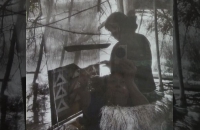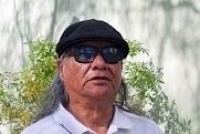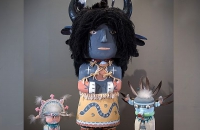P446 Pottery plate by Hopi potters Marty and Elvira Naha. The 10 1/4” plate with a Lizard was made by the coil method.
Both Marty and Elvira Naha come from a long line of potters, and actually share distant relations with Nampeyo. (Elvira being the great-granddaughter of Nampeyo)
"The Lizard Kachina is one of the Fighting Kachinas, a group that furnishes individuals to chastise the clowns for their un-Hopi behavior. He is presumed to represent a particular species of lizard, the Crotophytus. This particular lizard is a brilliant turquoise color and very fast in movement.
"Should a young man meet one, he would address it as his friend and ask for a favorable interview with his sweetheart, hoping that the lizard would help him.
"The kachina usually appears in the Mixed Kachina Dance but may also be seen in the Powamu."
-Barton Wright, Kachinas: a Hopi Artist's Documentary (110)
About the Potters
Marty and Elvira Naha Nampeyoare a husband and wife team who are quickly getting the recognition they deserve in the field of pottery. They use their pottery to express Hopi Kachina culture, just like the cotton wood carvers.
Known for their development of the incised redware (introduced by Elvira's father, Tom Polacca), Marty and Elvira have nearly perfected the Kachina element captured in each of their unique pieces.
Both Marty and Elvira come from a long line of potters, and actually share distant relations with Nampeyo. (Elvira being the great-granddaughter of Nampeyo)
Their heritage and involvement with daily Hopi culture have given them an advantage. Their closeness with the Hopi way of life is represented as each piece nearly comes to life in the hands of an onlooker.
Having shown throughout the Southwest, Marty and Elvira's pieces can be seen in various galleries as well as publications dealing with elaborate Indian art. One such collection resides within the Heard Museum, in Phoenix, AZ. Also featured in the Museum of Indian Arts & Cultures, Santa Fe, NM.
This duo has appeared in publications such as Hopi-Tewa Potters by Gregory Schaaf, p. 101; and Fourteen Families in Pueblo Pottery by Rick Dillingham, pp. 14-15; and Art of the Hopi by Lois Essary Jacka, p. 110.















